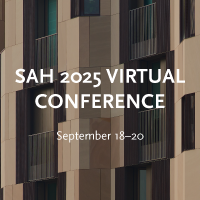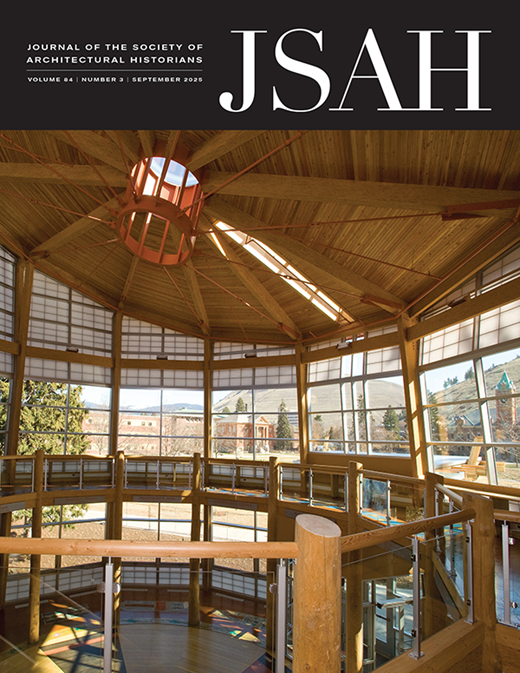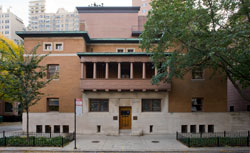-
Membership
Membership
Anyone with an interest in the history of the built environment is welcome to join the Society of Architectural Historians -
Conferences
Conferences
SAH Annual International Conferences bring members together for scholarly exchange and networking -
Publications
Publications
Through print and digital publications, SAH documents the history of the built environment and disseminates scholarship -
Programs
Programs
SAH promotes meaningful engagement with the history of the built environment through its programs -
Jobs & Opportunities
Jobs & Opportunities
SAH provides resources, fellowships, and grants to help further your career and professional life -
Support
Support
We invite you to support the educational mission of SAH by making a gift, becoming a member, or volunteering -
About
About
SAH promotes the study, interpretation, and conservation of the built environment worldwide for the benefit of all
Membership grants you access to exclusive resources and programs and provides support for new research and programs. Compare benefits across all our membership levels and choose the membership level that works for you.
Every Member Receives
- A yearlong subscription to the Journal of the Society of Architectural Historians (JSAH). Choose from digital access only or a combined print and digital subscription.
- On-demand access to the complete JSAH Archive (1941–present)
- Member rates for registration to SAH’s Annual International Conference
- AIA CES credits earned through conferences and study tours
- Eligibility to apply for SAH grants and fellowships
- Access to members-only lectures, virtual meetups, and more
- Connection to peers through 10 topic-focused SAH Affiliate Groups
- Access to more than 200,000 images of the built environment through the SAHARA database
- Access to SAH Commons online scholarly network
- Discount of 50% on JSTOR access with JPASS
- Eligibility to serve on the SAH Board or committees
- Subscription to the SAH Newsletter and Opportunities Weekly Roundup
Membership Levels
SAH Member
Our most popular membership tier offers optimized pricing to help everyone participate affordably in our community. Emerging scholars can apply for a one-year membership grant that helps bridge the gap between the Society's subsidized student memberships and full-cost SAH memberships.
| Rate | Description | Price: Digital | Price: Digital + Print |
| Individual | 12-month benefits for one person | $168 | $178 |
| Joint | 12-month benefits for two people (domestic partners). Each person receives a unique member ID and their own login to the member portal. | $240 | $250 |
| Retired/Emeritus | Discounted individual membership for former professionals on a fixed income | $101 | $111 |
| Reduced | Discounted individual membership for people working independently or at an institution without full-time employment. This includes adjunct and contingent faculty unemployed workers. | $101 | $111 |
| Global (Available Oct 1, 2025) | Affordable membership rates for global scholars living and working in countries the World Bank classifies as “low income.” | Scholars with qualifying addresses may receive up to 75% off the Individual Digital rate. Learn more. | |
| Student | Discounted individual membership for students currently enrolled in an undergraduate or graduate program in architectural history or related disciplines. | $62 | $72 |
| Professional Associate | Discounted individual memberships for groups of professionals working in the same museum, office, or firm. Ideal for architects, research or preservation groups, museum staff, and public design education. | $184 for first member + $106 for each additional member at the same institution | |
Upper-Level Member
Show your support for SAH’s mission by including a tax-deductible donation along with your Individual or Joint print + digital membership. Upper-level members receive all the benefits of a regular membership plus:
- Discount on registration for SAH Annual Conference, rates given below.
- Acknowledgement in four quarterly issues of JSAH, the annual report, and quarterly donor reports
- Membership to Frank Lloyd Wright National Reciprocal Sites Program, with which our headquarters, the Charnley-Persky House is affiliated.
- Early registration access for SAH Study and Excursion tours
| Tier | Donation | Price with Individual Membership | Price with Joint Membership | Discount on Annual Conference Registration |
| Cornerstone | $150 | $328 | $400 | 5% |
| Pillar | $350 | $528 | $600 | 7% |
| Keystone | $500 | $678 | $750 | 8% |
Life and Benefactor Member
Show your long-term commitment to SAH by becoming a Life member. Life members’ dues provide unrestricted funds to support the Society’s mission and continued opportunities for all members. Lock in your price and enjoy the most comprehensive suite of member benefits without the need to renew each year.
Life members receive these additional benefits:
- Acknowledgement in JSAH, annual report, and quarterly donor reports
- Membership to Frank Lloyd Wright National Reciprocal Sites Program, with which our headquarters, the Charnley-Persky House is affiliated.
- Early registration access for SAH Study and Excursion tours
- Specialty membership card
- Free tour of SAH's historic headquarters at the Charnley-Persky House in Chicago, IL
- One complimentary walking tour during SAH Annual Conference, reserved in advance, on a space-available basis.
- Free copy of an SAH Buildings of the United States book of your choice
Current Life Members can enhance their commitment to SAH by becoming a Benefactor through a $5,000 tax-deductible donation.
| Tier | Price | Donation Total |
| Life | $5,000 (one payment or four annual payments of $1,250) | None * |
| Benefactor | $10,000 | $5,000 |
* Life memberships are amortized over a period of 20 years and pay for annual benefits. There is no tax-deductible portion associated with Life membership.
President's Circle
SAH is immensely grateful to the many Life and Benefactor Members who continue to support the Society financially year after year. President’s Circle status recognizes the ongoing commitment these members show.
President’s Circle status is an annual distinction given to all Life and Benefactor members who make gifts to the Society of Architectural Historians totaling $1,000 or more during a given 12-month period. The status is applied to a donor as soon as they have achieved $1,000 in gifts within a single calendar year. The status is valid for 12 months from that date, and the date shall serve as an anniversary by which to renew their President's Circle status with one or more gifts totaling $1,000.
President's Circle members receive special benefits as thanks for their support:
- 10% discount on member-rate conference registration
- Recognition from the podium at SAH Celebrates annual gala
Limited-Access Affiliate
Affiliate Access permits one person to participate in the activities of one or more SAH Affiliate Groups and the SAH Commons online scholarly network, without access to any other SAH benefits such as JSAH or Membership registration rates for conferences or events. It is not considered an SAH Membership. Price is $25 per year.
Institutional Subscription
Institutional membership provides a subscription to JSAH and/or JSAH Online for communities of readers at public and academic libraries, museums, schools of architecture, architectural history departments, and other large institutions. Institutional subscribers receive the SAH Newsletter, qualify for discounted Career Center job ads, and member-rate registration for two library staff attending the SAH Annual International Conference.
The University of California Press handles institutional subscriptions on SAH's behalf. Visit the UC Press website to join or renew your Institutional subscription.
| Subscription Type | Price per Year | Additional Benefits |
|---|---|---|
| Digital Only | $693 | |
| Print + Digital - Domestic | $781 | |
| Print + Digital - International | $807 | |
| Sustaining | $881 |
|
Affiliate Groups
SAH Affiliate Groups are comprised of SAH members who share a common, narrowly defined interest, scholarly or otherwise. Participation in Affiliate Group activities is a benefit of SAH membership.
SAH Chapters
SAH has chapters located across the United States. Chapters are independently run organizations that are affiliated with SAH. SAH members can join chapters in their region.
Member Stories
A Career in Applied History: Catching up with Amber N. Wiley
Jun 24, 2025
by
SAH News
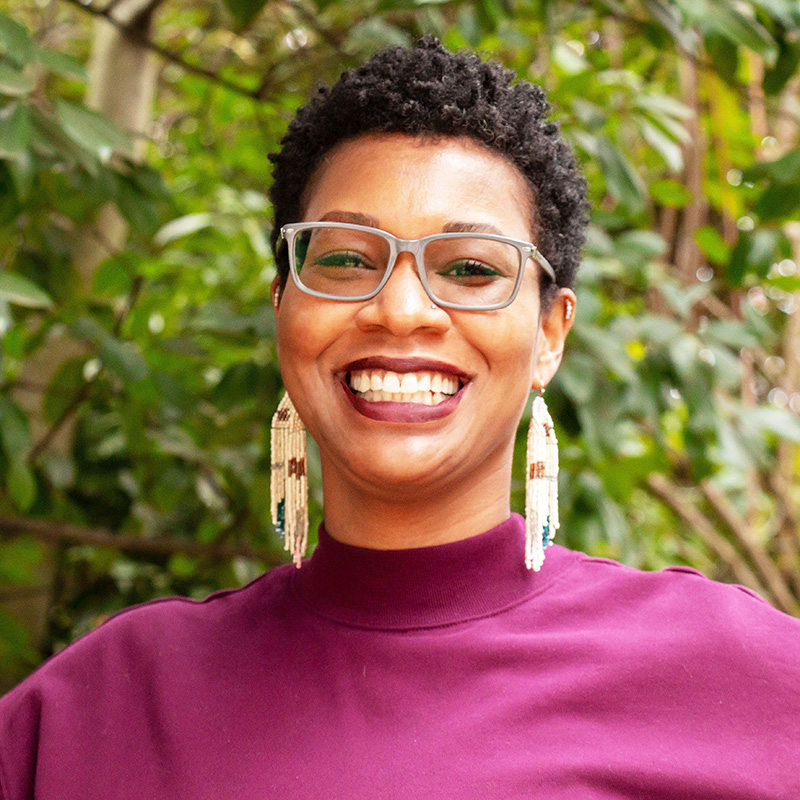
Amber N. Wiley is an Associate Professor of Planning, Landscape Architecture and Design and the Wick Cary Director of the Institute for Quality Communities in the Christopher C. Gibbs College of Architecture at the University of Oklahoma. She is also a 17-year SAH member and was the inaugural recipient of the Society’s prestigious H. Allen Brooks Traveling Fellowship, created in 2013.
Her research and teaching approach mixes architecture, sociology, and history into a unique form of analysis of how people perceive and influence the constructed world around them.
During her SAH-funded travels of the world in 2014, she visited countries in the Americas, Africa, and Asia to experience the physical influence of complicated histories: indigenous cultural practices, colonialism, war, shifts in political economy, stark inequities and heritage tourism.
Back in the United States, she has dedicated her professional career to advancing the history and narrative of design and preservation in Black communities. This spring, she celebrated the publication of her first monograph, Model Schools in the Model City: Race, Planning, and Education in the Nation's Capital. It is a part of the Culture, Politics, and Built Environment series edited by Dianne Harris for the University of Pittsburgh Press.
To kick off a new conversation series with SAH members about their careers, we spoke with Wiley about her new book, works-in-progress, and hopes for the future.
Amber’s interview responses have been lightly edited for brevity and clarity.
SAH: To begin, tell us a little about your background and career path.
AW: I am an Oklahoma City native and have just moved back to this city I love for the first time in 25 years. It’s great to be back!
I left it in 1999 to attend Yale University for a bachelor’s degree in architecture. I thought I would become a designer and architect, never a researcher and teacher. When I took a traditional western survey course taught by Christy Anderson, I was riveted by cave dwellings, by Stonehenge, by the wonders of ancient Greece. Because of that course I chose an undergraduate specialization in history, theory, and criticism.
In my senior year, I joined a graduate-level seminar on historic preservation taught by longtime SAH member Catherine “Tappy” Lynn. It changed my life! It felt like all the history I had been learning and loving was finally applied to something of today. I was fully engrossed in the research.
I chose to pursue a Master’s degree at University of Virginia’s School of Architecture and then a Ph.D. in American Studies at George Washinton University. My path crossed with more SAH members as my professors and advisers: Dell Upton, Daniel Bluestone, Richard Longstreth, as well as Suleiman Osman and John Michael Vlach.
SAH: How did you first become involved with SAH?
AW: The University of Virginia has a student chapter of SAH, which I joined when I arrived there in 2003 to start my Masters. We planned field trips and invited lecturers to come speak to the group. When I moved on to George Washington University, I joined the Latrobe Chapter in D.C. I was one of the younger members, so they made me their web master. Both of those opportunities made me interested in participating on the national level.
In 2008, received a Richard Hubbard Howland fellowship from national SAH to attend a Louis Kahn study tour of New Jersey, Philadelphia and New York. As a grad student, I was intimidated to be traveling with professional scholars, but after spending eight days together, I felt empowered. They encouraged me to go to the annual international conference, and for the first time I felt that I belonged there because I knew other attendees. It was a great experience that helped me be bolder going forward in my career.
SAH: Now 17 years later, your first book has been released. Where did inspiration for ‘Model Schools’ originate?
AW: I have been working on this subject for nearly a decade in various ways — as a paper assignment, my doctoral thesis, and additional research for the book itself.
It started in a graduate seminar with Suleiman Osman as he began his tenure-track career with George Washington University. The course was an intense research seminar on a topic of our choosing related to Washington D.C.
My classmates were choosing a variety of topics to pursue: music history of the city, LGBTQIA history, integration at GW, etc. I wanted to write a history of Paul Laurence Dunbar High School. At the time, I only knew about Dunbar as a famed machine of excellence, producing important Black alumni and lead by noteworthy administrators and teachers. It was the first public high school for Black students in the country, and as archivist Kimberly Springle later told me, and it was the first public high school anywhere in the city. That fact is not well-known.
I just wanted to walk in its hallowed halls, you know? I wanted to soak in all that good energy and excellence. So, in the era before GPS navigation, I printed out driving directions from MapQuest and made my way to the neighborhood. As I pulled up, I wondered if I had entered the right address. What I saw was not the 1870s red brick and white porticoed building I had imagined – something that I believed would look old and esteemed, you know – but a high-rise brutalist building that looked like a prison with its minimal windows. Quite frankly, it was dirty and depressing. And I thought, ‘What happened here?!’ and that was the research question that drove me that semester.
I was interested in why Black folks built Brutalist schools. For my dissertation topic – at the recommendation of Richard Longstreth – I completed a comparative analysis of schools built from 1960 to 1980 for Black students in Philadelphia, DC, and Atlanta. Black residents at that time felt that integration wasn’t truly happening in the existing schools, so they said, ‘Let us address the need for larger, innovative schools in our neighborhood.’ And when they did, they were all built in a particular idiom.
SAH: The thesis of your book, to borrow from the book jacket, is that “the school building was the physical realization of Black liberation.” How did you arrive at that idea?
AW: Yes! That’s it exactly.
When I began working on the book (as opposed to the dissertation), I narrowed the geography down to focus on Washington D.C. but extended the timeline I was exploring. I started in the Antebellum period, when learning to read and write was outlawed for enslaved African Americans.
In the first chapter of my book, I present an 1862 image by Mathew Brady of a group of young, newly freed people in a Union camp in Washington D.C. posing with books in their hands. They were still in the middle of the Civil War. To start reading was a major act of defiance and signifier of freedom. With the publication of this photo, the Union effectively taunted the Confederacy, 'We've now got your property and we've got them reading.' Whether or not all of those people posing could actually read is questionable, but the image is nonetheless powerful.
After establishing education as a long-sought path to freedom, we move on to the incorporation of a public school system in D.C. and into the era of "separate-but-'equal'" policies, which we know were not, in practice, equal at all .
I follow the ways in which Black Washingtonians continued to fight for equality in the local schools. In the mid-twentieth century, there was an equalization strategy before there was a desegregation strategy. Black parents were pushing for equivalent facilities and funds to their white counterparts. Desegregation wasn’t as important as their kids being able to go to decent schools with quality facilities, books, and equipment. The physical buildings that existed were falling down around these students.
SAH: How does that bring us back to Paul Laurence Dunbar High School and its Brutalist architecture?
AW: The 1916 school facility ended up being so overcrowded and overrun — and earned a complicated reputation for intra-racial discrimination and elitism — that people argued for a replacement. Dunbar was redone in 1977 as part of an urban renewal program heralded by Revered Walter Fauntroy. Black architects Bryant & Bryant designed the Brutalist building that I saw (and loathed) on my visit in 2006 at the advocacy of Charles Cassell, a Black architect serving on the school board at the time. It blew my mind. Black architecture firms building and designing Brutalist-style schools in the 1960s and 1970s was a full-blown movement and an act of self-determination. It was the first time some of these firms got commissions this large.
Imagine the motivation: 'We finally have the ultimate say-so in our schools, and we will make them the most innovative, up-to-date, whatever-the-trend-is design. We're going to do it!'
And they did it to death. Some of these schools... they were wild. When they were new, people loved them and found them impressive. They represented excellence for the Black professional community and its future through its students.
SAH: What do you hope people will feel when they read your book?
AW: One of my pet peeves is the assumption that there are no resources on Black architectural history, and the assumption that Black people have never talked about buildings before. There are so many conversations that happen throughout this book that show Black people thinking about what a well-planned school building looks like, what the size of a school lot should be, can the design accommodate the number of students we have, and attention to aesthetics, circulation, and program. And it isn’t just the architects: These are parents, PTA advocates, sororities, lawyers, real estate professionals, barbers, and dentists. These non-experts in architecture could say 'There's something wrong with this school building, and let me tell you what it is.'
What I want readers to take away is that there is not, in fact, a dearth of source materials about Black approaches to design. Architecture has always been important to us, and this book is one of the ways I can share that.
SAH: While I’m sure promotion for ‘Model Schools’ is keeping you busy, what other projects are you working on?
AW: So glad you asked! I am currently working for the Associate for the Study of African American Life and History (ASALH) on a grant from the National Park Service to conduct a preliminary study on Black high schools that operated during the era of segregation. It's called the "Black Public High Schools 1870-1970 Project." The schools in NPS’s National Historic Landmark (NHL) Program – if they are Black public schools, in particular – are from the era of de-segregation. Not much is said about the good work being done in the era before that. Our goal is to offer suggestions for how to identify and nominate Black public high schools as NHLs.
I also have a second book in the works. It will be an edited volume entitled Collective Yearning: Black Women Artists from the Zimmerli Art Museum about an exhibition on Black women artists my students in the Art History department at Rutgers University produced a few years ago. It will include images of the exhibit installation; prints, paintings, and photographs they chose for the exhibition; and interviews and essays from the students.
It’s not a catalogue per se, but a pedagogical guide explaining how the exhibition grew out of a seminar, which grew out of a survey course assignment. I will contribute material on the pedagogical process for applied history and applied research.
Another callout to an SAH member: Carla Yanni encouraged me to apply for the Assistant Professorship at Rutgers. Thanks to her advocacy, I was based in the art history department there and taught courses for both its Cultural Heritage and Preservation Studies program and Curatorial Studies program.
SAH: What piece of career advice would you share with your former yourself and those reading this article?
AW: Read more Black feminist books! When you are an architecture major, they don't put bell hooks and Audrey Lorde on the reading list, yet they both talk about structures, history, and memory. In both fiction and non-fiction — read more Black feminist authors.
Because of expanding my reading practice with these figures, I feel like I have entered a new era of understanding that empowers me to talk about place in ways I wish I had been able to 10 or 15 years ago.
SAH: Is it new vocabulary they are offering you, or something else?
AW: Some of the realization is in having these wise people reframe concepts we sometimes take for granted. For example, we might be taught in a classroom about Western versus Eastern cultural norms for thinking about time as linear versus circular, respectively. In reading Octavia Butler, though, I find myself considering that time is all these things (and more!) and that makes me approach my work in new ways.
It goes back to my comment that Black people have been talking about built environment for a while. Take for example Ralph Ellison's The Invisible Man, which I am currently reading Ellison (an Oklahoma City native, too!) attended Tuskegee University. In the story, he describes how it feels for a young Black man to step foot on a collegiate campus. He doesn't say in the book that this is Tuskegee, but it is clear from the descriptions of red brick and the columns that mimic the columns of the plantations a few miles away, that he is drawing directly from the built environment of his alma mater. He mentions an iconic statue of “The Founder.” Having visited the campus, I know from his description it is the real-life Booker T. Washington sculpture. It's a piece of fiction, but he has captured a place in recognizable detail, cataloging it and its meanings through one person's viewpoint.
There are research articles about Tuskegee’s campus and racialized landscapes therein that are considered highly groundbreaking, but now I see Ralph Ellison writing in the 1950s about the same complex understandings of space, place, and time. I want more of us to recognize that sources of knowledge can come from beyond the reference desk.
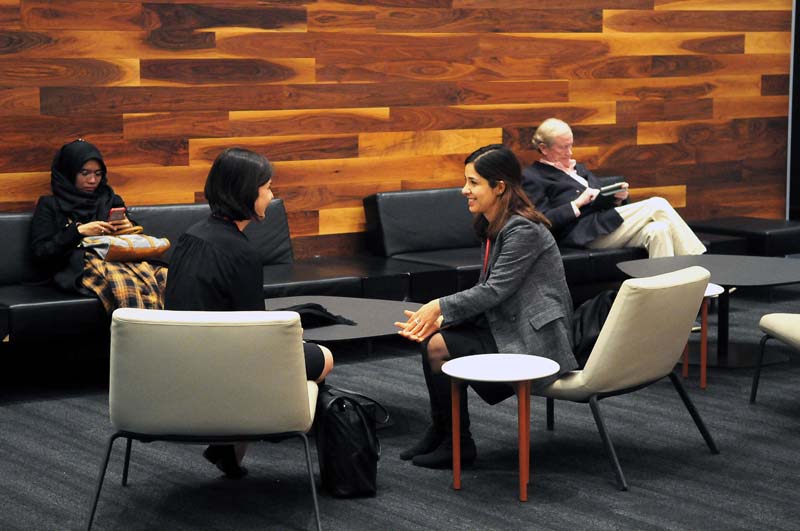
Membership Grants
Emerging scholars can apply for a one-year membership grant that helps bridge the gap between the Society's subsidized student memberships and full-cost SAH memberships.
